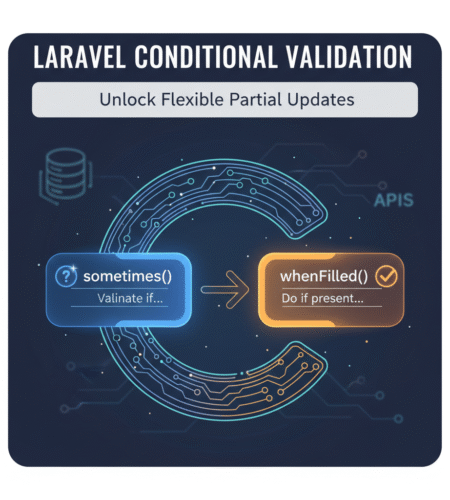Introduction
When building modern APIs or form-driven applications, Laravel validation gives you elegant tools to keep your data clean and consistent. But things get trickier with partial updates, where users may only update one or two fields. That’s where Laravel’s conditional helpers — sometimes() and whenFilled() — shine. In this guide, we’ll break down how each works, when to use them, and how to combine both for flexible and powerful validation logic.
When building APIs or web forms, conditional validation becomes crucial — especially when handling partial updates (like PATCH requests).
In Laravel, two methods often come up for this: sometimes() and whenFilled().
At first glance, they sound similar — but they serve different purposes.
Let’s explore both in depth with practical examples.
The Problem: Partial Updates
Imagine you have an endpoint to update a user profile:
PATCH /api/users/{id}
You want users to be able to update only the fields they provide — without forcing them to resend everything. For example, they might just want to update their name or password, not both.
The sometimes() Method
The sometimes() method lets you apply rules only under certain conditions.
How It Works
When you define your validator, you can specify that a rule should apply “sometimes” — depending on a condition you provide as a closure.
Example:
$validator = Validator::make($data, [
'email' => 'email',
'password' => 'min:8',
]);
$validator->sometimes('password', 'required', function ($input) {
return isset($input->email);
});
What happens here:
- The
passwordfield is only required ifemailis present in the input. - If the user doesn’t send
email, Laravel won’t complain about the missing password.
Perfect for conditional validation — like “only require this field when another one is provided.”
The whenFilled() Method
whenFilled() is a newer and more expressive approach introduced in Laravel 9.
How It Works
This method runs your callback only if the field is both present and not empty.
In other words:
“If this input is filled, then do something.”
Example in a Form Request
public function passedValidation()
{
$this->whenFilled('password', function ($value) {
$this->merge(['password' => bcrypt($value)]);
});
}
What happens here:
- If the
passwordfield is filled (not null or empty), it will be automatically hashed. - If it’s missing or empty, Laravel skips this logic entirely.
Using Both in a Partial Update (PATCH) Request
Here’s a practical example combining the two in a User Update Form Request:
class UpdateUserRequest extends FormRequest
{
public function rules(): array
{
return [
'name' => ['sometimes', 'string'],
'email' => ['sometimes', 'email', 'unique:users,email,' . $this->user->id],
'password' => ['sometimes', 'string', 'min:8'],
];
}
public function withValidator($validator)
{
// Only apply confirmation if password is present
$validator->sometimes('password', 'confirmed', function ($input) {
return !empty($input->password);
});
}
public function passedValidation()
{
// Automatically hash password if filled
$this->whenFilled('password', function ($value) {
$this->merge(['password' => bcrypt($value)]);
});
}
}
What’s Happening:
sometimes()ensures fields are only validated if they exist in the request.- The
sometimes(..., 'confirmed', ...)rule applies password confirmation only when password is sent. whenFilled()ensures password hashing only happens if the user provided one.
This combination makes the form robust and flexible — ideal for PATCH routes where only some fields are being updated.
Key Differences
| Feature | sometimes() | whenFilled() |
|---|---|---|
| Purpose | Add rules conditionally | Perform actions conditionally |
| Runs when… | A custom condition (closure) is true | The field is present and not empty |
| Scope | Validator logic | Form Request or manual callback |
| Typical use case | “Validate this only if…” | “Do this only if field is filled” |
| Good for | Conditional validation rules | Conditional data manipulation |
Quick Tip: Combine with filled Rule
Sometimes you just want to validate a field only if it’s filled.
Laravel’s built-in filled rule can simplify this too:
'password' => ['filled', 'string', 'min:8'],
That tells Laravel:
“Validate this rule only when the field is filled.”
You might still use whenFilled() for extra behavior, like hashing or transforming input.
Conclusion
Both sometimes() and whenFilled() give you fine-grained control over conditional validation in Laravel:
- Use
sometimes()to apply rules dynamically. - Use
whenFilled()to perform actions (like hashing) only when data is present.
Together, they make your validation logic cleaner, smarter, and perfectly suited for partial updates.


Comments